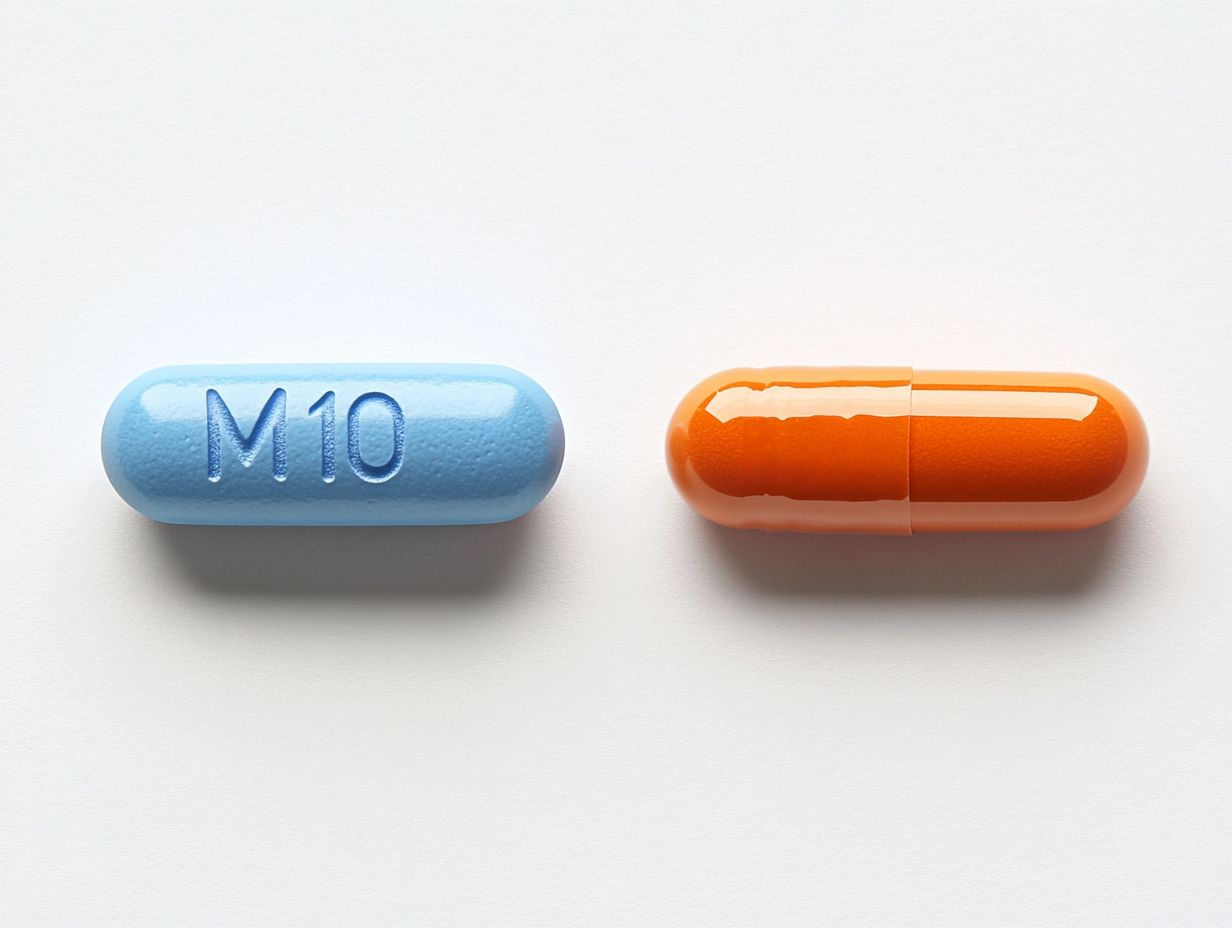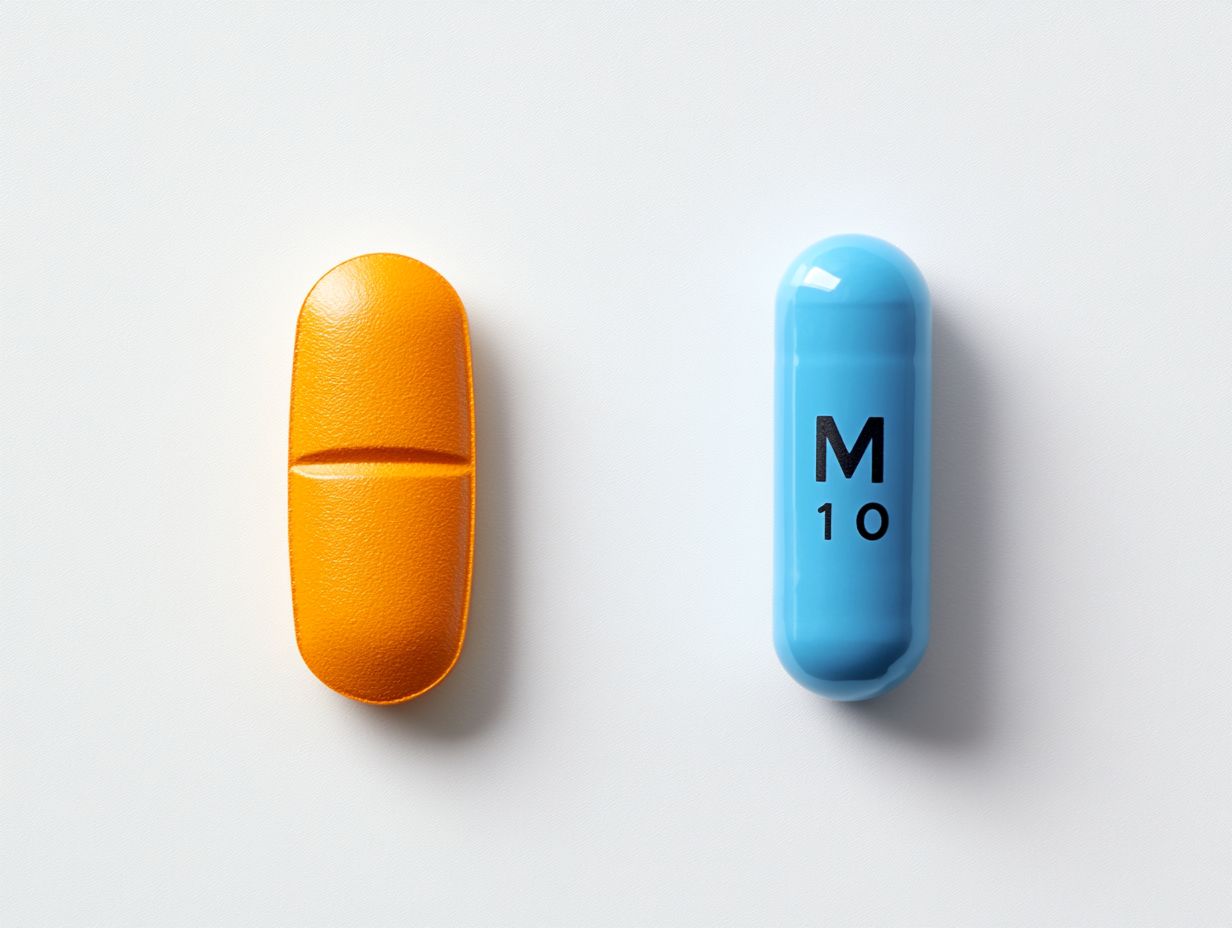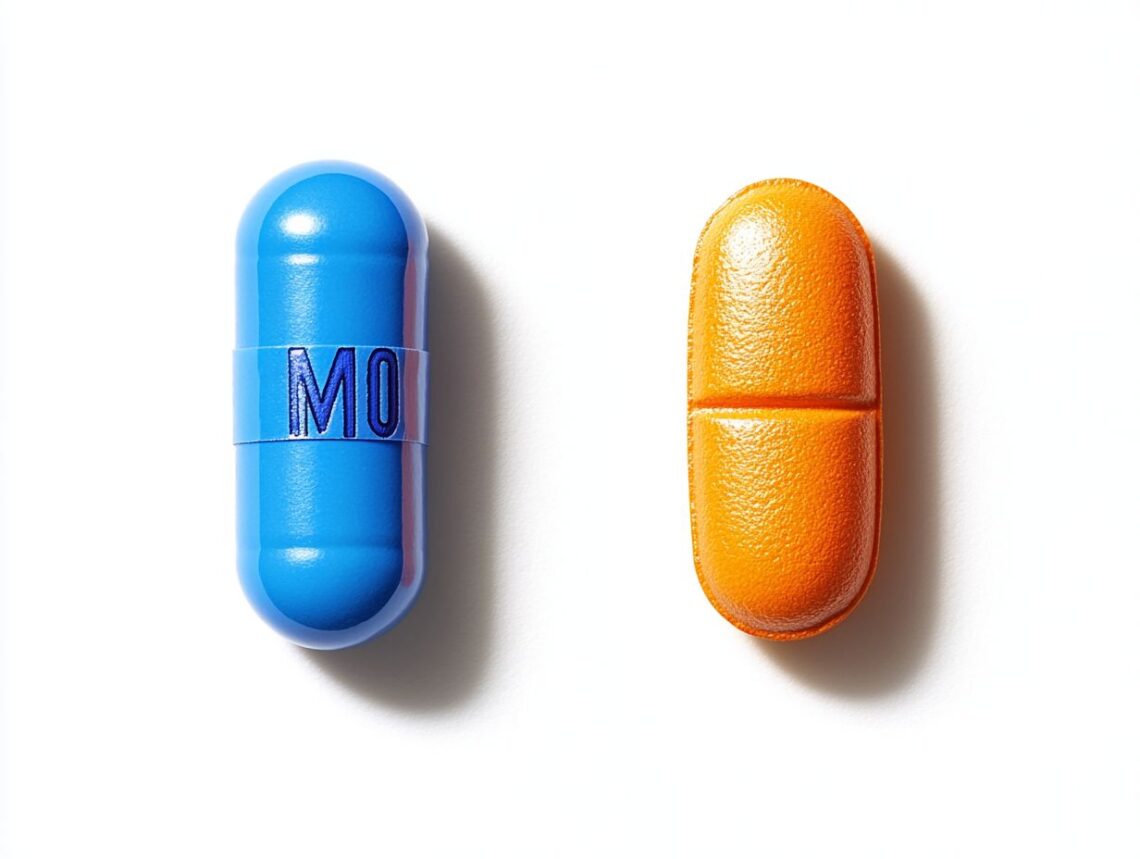Navigating the realm of ADHD medications can be quite complex, particularly given the wide array of options available, including stimulant medications and various formulations.
Among the commonly discussed treatments are the m 10 pill and Adderall, both of which are designed to enhance focus and mitigate impulsivity.
This guide offers a comprehensive comparison of these medications, examining their similarities and differences, effectiveness, potential side effects, and safety considerations.
Additionally, it addresses important considerations to discuss with your healthcare provider regarding treatment options, including dosage information, potential drug interactions, and alternatives to these medications.
Whether you are seeking clarity for yourself or for a loved one, this guide provides the necessary knowledge to make informed decisions regarding ADHD treatment.
Key Takeaways:
Understanding ADHD Medications

A comprehensive understanding of ADHD medications is essential for patients and caregivers, as these therapeutic agents are integral to the management of Attention Deficit Hyperactivity Disorder (ADHD) and Narcolepsy. These medications, such as Adderall and Dexedrine, belong to the CNS stimulants drug class.
Among these medications, M 10, which contains Amphetamine and Dextroamphetamine, plays a pivotal role in the treatment landscape. Manufactured by Mallinckrodt Pharmaceuticals, these CNS stimulants are classified as Schedule II controlled substances due to their potential for addiction and are available only by prescription. It is important to understand the pregnancy category risk and the need for medical supervision when prescribing these medications.
It is imperative to consider a range of factors when discussing treatment options, including effectiveness, safety considerations, potential for substance abuse, and drug-induced insomnia to ensure optimal patient outcomes.
Overview of m 10 Pill and Adderall
The M 10 pill and Adderall are both prescription medications primarily utilized for the treatment of Attention Deficit Hyperactivity Disorder (ADHD) and Narcolepsy. M 10 comprises a combination of Dextroamphetamine and Amphetamine salts, while Adderall is a well-established brand that serves a similar purpose but may differ in inactive ingredients and formulation specifics. Manufactured by Mallinckrodt Pharmaceuticals, both are classified as Schedule II controlled substances, necessitating careful medical supervision to mitigate potential risks associated with their use, including addiction and growth suppression.
When comparing these medications, it is essential to recognize that both formulations are designed to enhance concentration and reduce impulsivity by increasing levels of neurotransmitters such as dopamine and norepinephrine in the brain.
The dosages for both M 10 and Adderall typically commence at a lower level to assess patient tolerance and are gradually adjusted based on individual response. For example, M 10 is often prescribed in doses ranging from 5mg to 40mg per day, whereas Adderall is available in both immediate-release and extended-release forms with varying dosages.
Prescribing practices may vary; some healthcare providers may prefer one medication over the other depending on the patient’s specific needs and their response to the formulation.
Both medications provide educational materials and support programs to assist patients in navigating potential side effects, such as serotonin syndrome, and ensuring adherence to their respective treatment plans.
Comparison of m 10 Pill and Adderall
A comprehensive comparison of M 10 and Adderall highlights both similarities and differences that are essential for patients to consider when discussing their treatment options for Attention Deficit Hyperactivity Disorder (ADHD).
Both medications contain stimulant components, specifically Dextroamphetamine and Amphetamine salts, which affect neurotransmitter activity in the brain to improve focus and control impulsivity. These medications are a crucial part of therapy for managing ADHD and narcolepsy symptoms.
However, they vary in formulation, inactive ingredients, and side effects. Therefore, it is crucial for healthcare providers to customize their recommendations based on the individual needs and treatment goals of each patient. For more information on the differences, see m 10 pill vs adderall.
Similarities and Differences
When comparing M 10 and Adderall, several similarities and differences become evident that can significantly influence a patient’s treatment choice. Both medications contain Dextroamphetamine and Amphetamine, rendering them effective for managing symptoms of ADHD and Narcolepsy. The choice between these medications often depends on individual patient feedback and healthcare provider assessments.
However, they may differ in terms of side effects, prescription costs, and patient feedback regarding their experiences with each medication.
Healthcare providers frequently observe that while both options can enhance focus and alertness, they may provoke varying emotional and physical responses from patients. For example, some individuals report experiencing more pronounced side effects, such as insomnia or anxiety, with one medication compared to the other, which can affect adherence to treatment plans.
Additionally, the cost of these medications can differ, making accessibility a crucial factor in the decision-making process.
Patients are encouraged to engage in open communication regarding their experiences and preferences, which enables healthcare providers to tailor recommendations that take into account not only the effectiveness of these medications for ADHD and Narcolepsy but also their tolerability, potential mental health effects, and overall impact on quality of life.
Effectiveness of m 10 Pill vs Adderall

The comparative effectiveness of M 10 Pill and Adderall is an important factor for individuals seeking treatment for ADHD and Narcolepsy, as both medications offer substantial benefits in symptom management.
The therapeutic applications of each medication vary somewhat based on the individual patient’s needs and their response to treatment, highlighting the necessity of personalized prescribing practices and medical oversight.
A thorough understanding of the mechanisms of action of these medications can significantly enable patients to participate actively in their treatment plans and enhance overall health outcomes. Resources such as patient tips and support groups can further aid in this process.
Which Medication Works Better?
Determining the most effective medication for a patient, whether M 10 or Adderall, necessitates a careful consideration of various factors, including individual responses, side effects, and patient feedback. Both medications are designed to manage Attention Deficit Hyperactivity Disorder (ADHD) and narcolepsy effectively; however, patient experiences can vary significantly.
Therefore, it is essential for healthcare providers to customize treatment plans based on ongoing assessments and feedback.
Evaluating these medications requires a comprehensive approach that encompasses healthcare provider assessments and comparative studies that illustrate the efficacy and tolerability of each option. It is critical to monitor patient reactions to treatment, as some individuals may derive greater benefit from one medication due to a more favorable side effect profile or improved focus and energy.
Adjusting treatment plans based on regular evaluations not only promotes better outcomes but also fosters a collaborative environment in which patients feel enabled to discuss their progress and challenges. This personalized approach ensures that the selected medication aligns closely with the unique needs of the patient, ultimately enhancing their overall well-being. For more information on medications, you can compare m 10 pill vs adderall.
Potential Side Effects of m 10 Pill and Adderall
The potential side effects of M 10 Pill and Adderall represent a critical component of treatment that patients and healthcare providers must address to ensure the safe use of these medications.
Both medications can be effective in managing ADHD and narcolepsy; however, they may induce a variety of side effects. These can range from more common issues, such as insomnia and appetite suppression, to rarer complications, including serotonin syndrome.
Facilitating open communication regarding these risks is essential in helping patients navigate their treatment journey more effectively.
Common and Rare Side Effects
Common side effects of M 10 and Adderall include insomnia, decreased appetite, and increased heart rate, all of which can significantly affect a patient’s daily functioning. Conversely, while rare side effects occur less frequently, they can present serious health risks, such as serotonin syndrome, which necessitates immediate medical intervention. Patients should also be aware of potential drug interactions and the importance of adhering to prescribed dosages to avoid complications.
A thorough understanding of these potential side effects is essential for effective management and ensuring safety during treatment.
Patients may experience not only physical symptoms but also psychological effects, including anxiety, irritability, and mood swings, which can further complicate their overall health. Vigilant monitoring of these reactions is crucial, as it enables healthcare providers to customize treatment strategies aimed at minimizing discomfort. This approach also considers the potential for substance abuse and the need for comprehensive mental health support.
Some individuals may encounter severe outcomes, such as cardiovascular complications or worsening of pre-existing conditions. Safety considerations, including FDA alerts and cost comparison, are of utmost importance; therefore, maintaining ongoing communication with healthcare professionals is vital to promptly address any concerning changes.
Regular follow-up appointments are instrumental in adjusting dosages appropriately and mitigating risks associated with both common and rare side effects, ultimately contributing to an improved quality of life.
Considerations Before Taking M 10 Pill or Adderall

Ahead of initiating treatment with M 10 Pill or Adderall, which contain amphetamine salts and are classified as CNS stimulants, it is essential to engage in a comprehensive discussion with a healthcare provider to ensure the safe and effective management of Attention Deficit Hyperactivity Disorder (ADHD) and Narcolepsy.
Key considerations include the patient’s personal health history, possible drug interactions, and specific risks linked to stimulant medications, particularly in relation to pregnancy categories and any pre-existing medical conditions, as well as the Schedule II status of these controlled substances.
An in-depth understanding of these factors is critical for formulating an effective treatment plan tailored to the therapeutic uses of M 10 Pill, which is produced by Mallinckrodt Pharmaceuticals, and customized to meet the individual needs of the patient.
Factors to Discuss with a Healthcare Provider
Important factors to discuss with a healthcare provider prior to initiating treatment with M 10 or Adderall, which contain amphetamine and dextroamphetamine, include the patient’s medical history, pre-existing conditions, and the potential risks associated with stimulant medications. It is essential to understand how individual health factors can influence the effectiveness of treatment in order to tailor a comprehensive treatment plan that aligns with the patient’s needs and lifestyle, considering the potential for growth suppression and drug-induced insomnia.
In addition to these fundamental components, it is critical for individuals to provide details regarding any previous medication trials, as this information can offer valuable insights into their responses to similar treatments. Family history is also an important consideration; if there is a history of substance abuse or addiction, this may significantly impact the prescribing approach and involve careful medical supervision.
Furthermore, any current medications—including over-the-counter supplements or herbal remedies—should be disclosed, as they may have adverse interactions with the prescribed stimulant, potentially leading to serotonin syndrome. Engaging in an open dialogue with the healthcare provider not only fosters trust but also increases the likelihood of achieving optimal treatment outcomes.
Alternatives to M 10 Pill and Adderall
Exploring alternatives to M 10 Pill and Adderall is crucial for patients who may experience side effects or seek different treatment options for Attention Deficit Hyperactivity Disorder (ADHD), as well as Narcolepsy.
A variety of medication options, encompassing both stimulant (such as Dexedrine and amphetamine sulfate) and non-stimulant medications, are available to offer tailored therapeutic approaches based on individual patient needs and responses to treatment.
Gaining an understanding of these alternatives can enable patients to engage in informed discussions with their healthcare providers regarding their treatment plans.
Other Medication Options for ADHD
In addition to M 10 and Adderall, which are prescription medications, various other options are available for the effective management of ADHD symptoms.
Stimulant medications, such as Dexedrine (dextroamphetamine sulfate), offer an alternative treatment pathway, while non-stimulant options like Atomoxetine and Guanfacine serve as alternatives for patients who may experience adverse effects from stimulants. Each of these medications possesses a distinct mechanism of action and potential side effects, underscoring the necessity for personalized treatment plans.
Stimulants primarily function by increasing the levels of specific neurotransmitters in the brain, which can enhance focus and diminish impulsivity. However, they may also result in side effects such as insomnia, appetite suppression, and increased heart rate.
In contrast, non-stimulant medications operate differently; for example, Atomoxetine selectively inhibits the reuptake of norepinephrine, providing therapeutic benefits with fewer side effects, such as sedation or fatigue.
This array of medication options emphasizes the importance of continuous collaboration with healthcare providers, ensuring that treatment is customized to meet individual needs while optimizing efficacy and minimizing adverse effects, taking into consideration factors such as FDA alerts and prescribing practices.
Frequently Asked Questions

What is the difference between M 10 Pill and Adderall?
M 10 Pill is a generic version of the medication Adderall, which is used to treat ADHD and Narcolepsy, and contains the same active ingredients: amphetamine and dextroamphetamine.
Are M 10 pills and Adderall interchangeable?
Yes, M 10 pills and Adderall contain the same active ingredients and are considered interchangeable in most cases.
Do M 10 pills and Adderall have the same dosage?
M 10 Pills and Adderall can have different dosages, such as 10 mg, depending on the manufacturer. It is important to follow the recommended dosage prescribed by your healthcare provider and consider the inactive ingredients that may vary.
Which one is more cost-effective, M 10 Pill or Adderall?
Since M 10 Pill is a generic version of Adderall, it is usually more cost-effective than Adderall. However, the prices may vary depending on the manufacturer and pharmacy, and factors such as insurance coverage and cost comparison should be considered.
Do M 10 pills and Adderall have the same side effects?
Yes, M 10 pills and Adderall have the same potential side effects, as they contain the same active ingredients. It is important to consult with your doctor if you experience any side effects.
Can I switch between M 10 Pill and Adderall?
In most cases, you can switch between M 10 Pill and Adderall. However, it is important to consult with your healthcare provider before making any changes to your medication regimen and to consider safety considerations, patient tips, and support groups for additional guidance.





